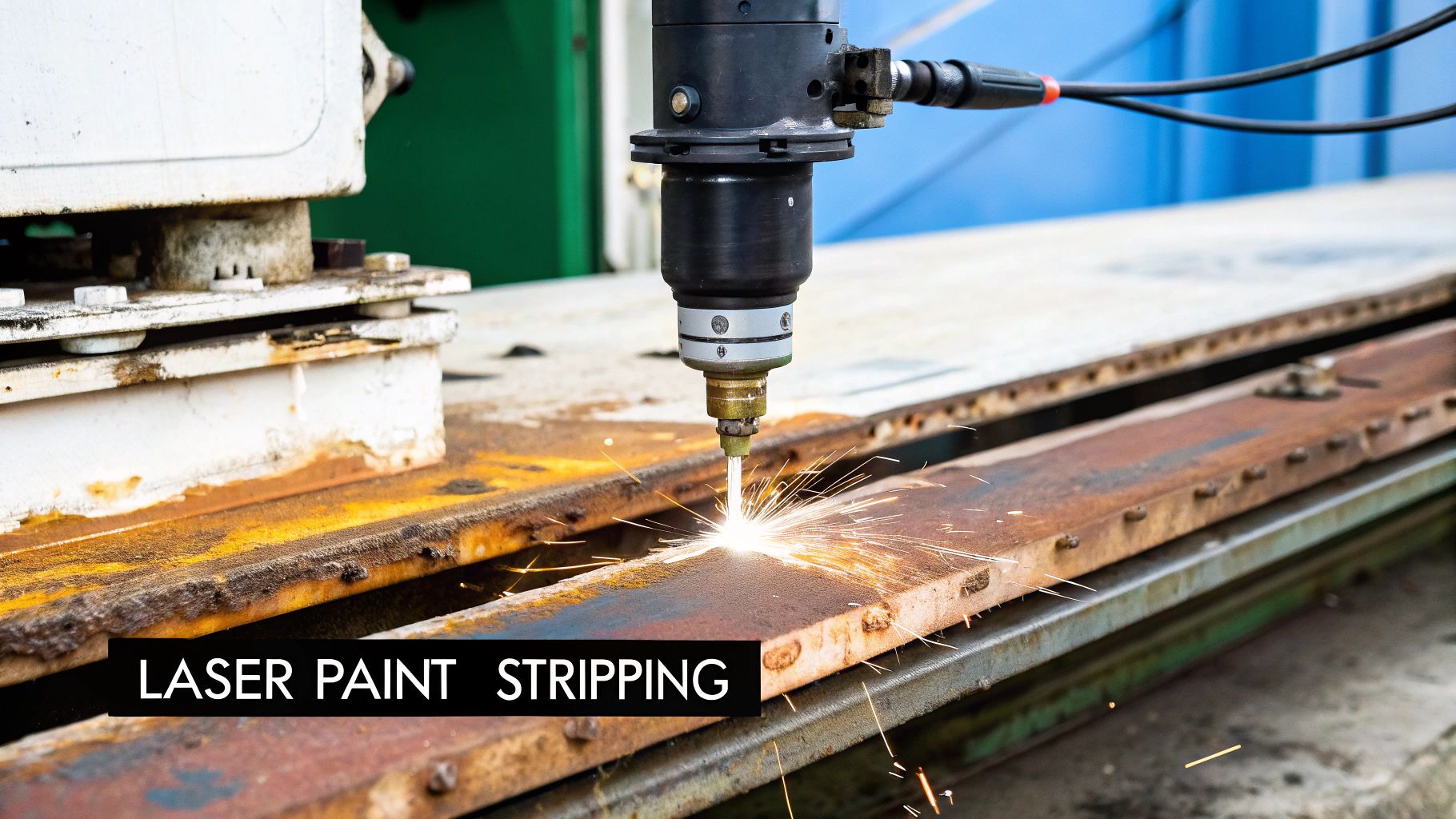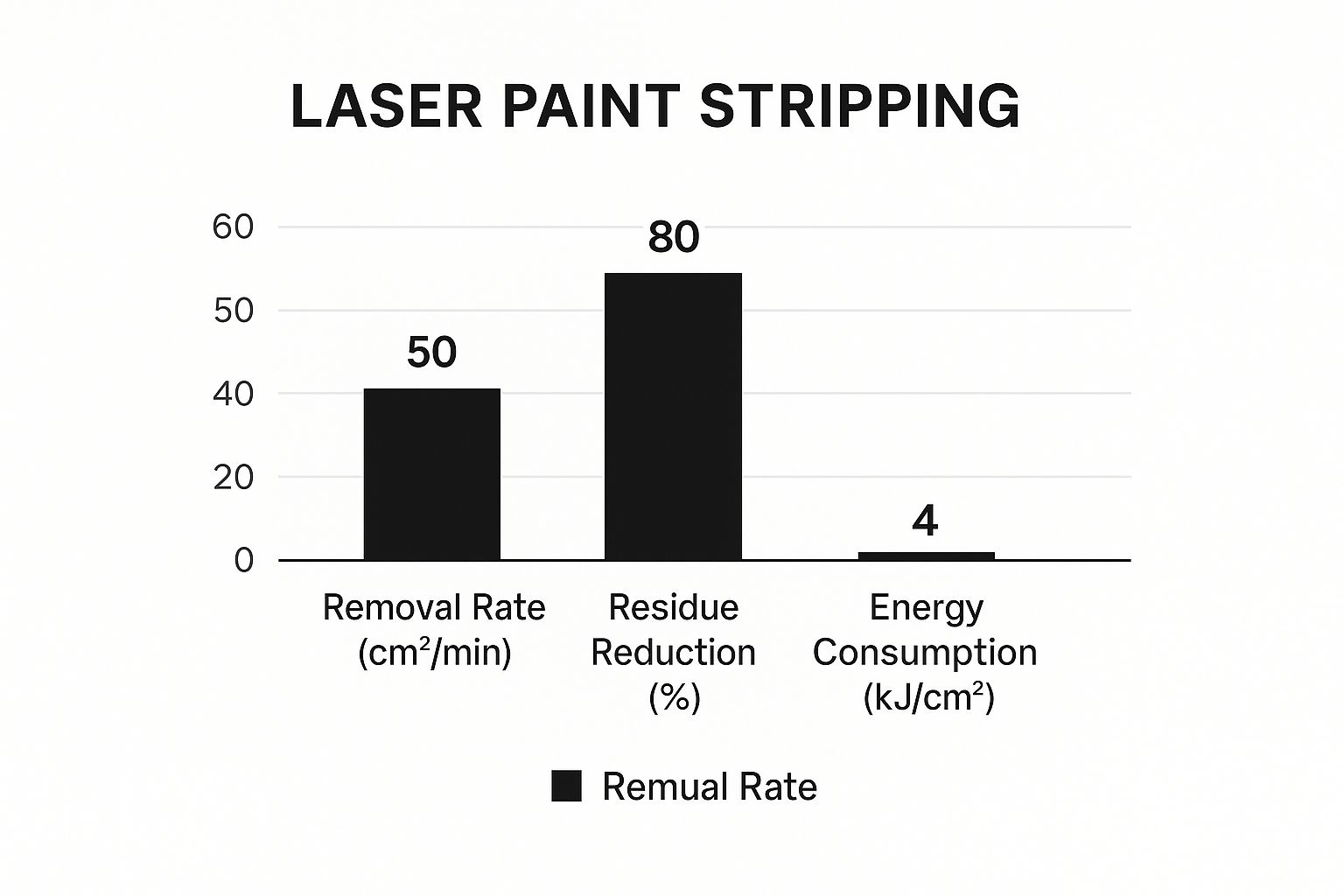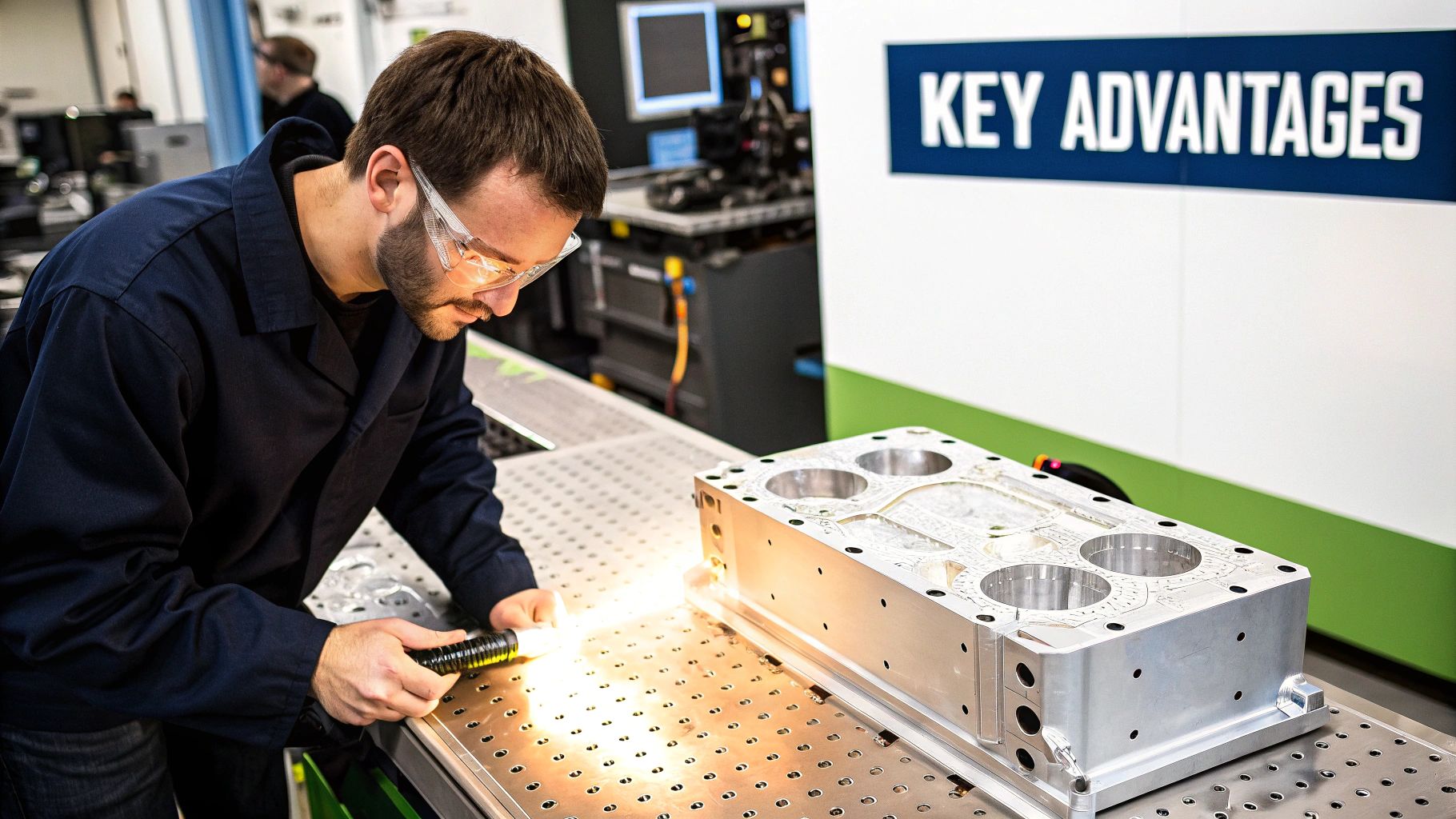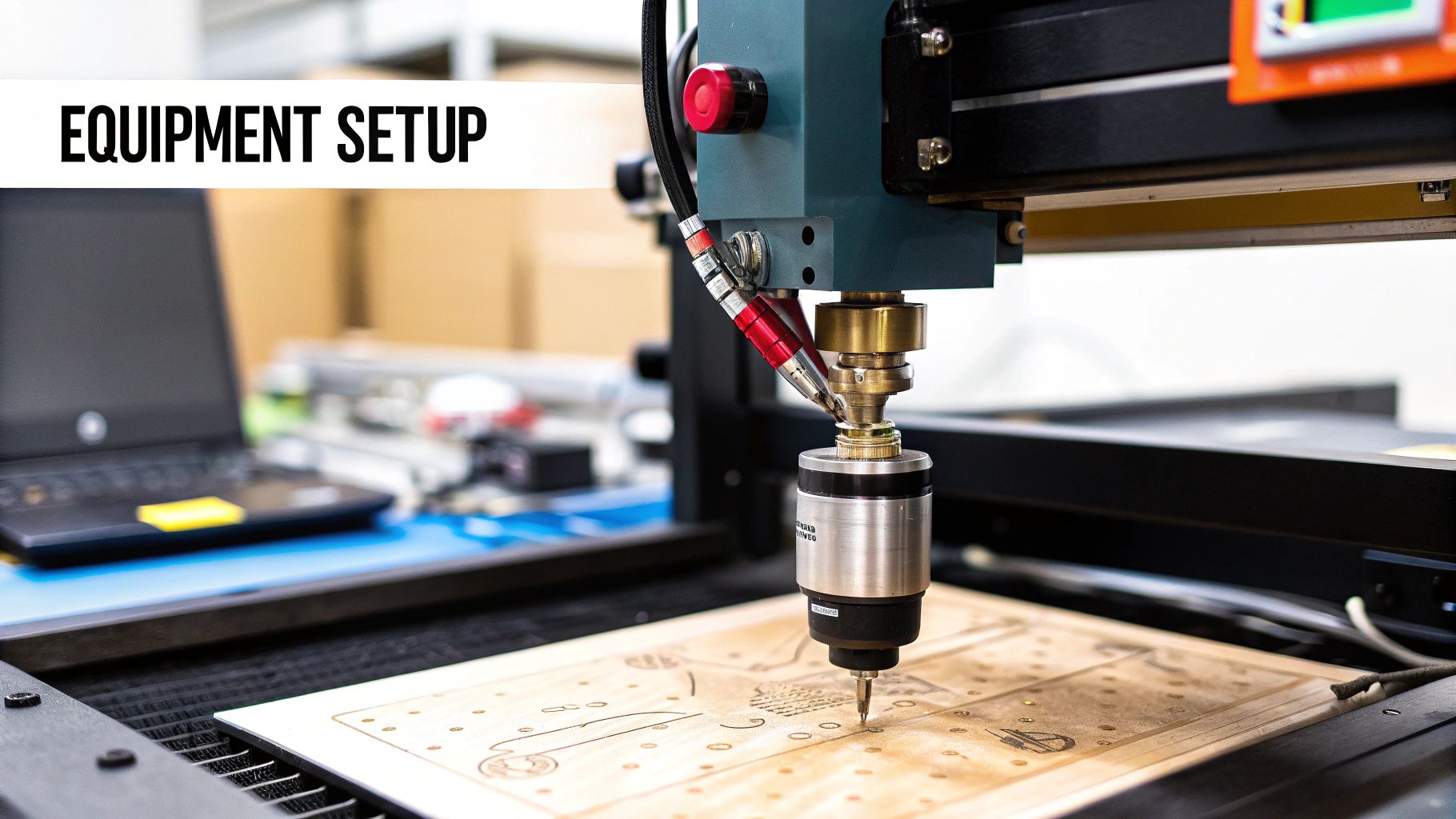Paint Stripping Laser: The Future of Surface Restoration
- Laserverse

- May 29
- 12 min read
Understanding The Science Behind Paint Stripping Laser Technology

Paint stripping laser technology is changing surface restoration. It precisely removes unwanted coatings without harming the underlying material. This process, known as laser ablation, uses a focused laser beam to target the coating. The beam's energy is absorbed by the coating, causing rapid heating and vaporization, or sublimation. This precise removal is ideal for delicate surfaces where traditional methods might cause damage. For a deeper dive into the mechanics of this process, check out this helpful resource: How laser cleaning works.
Wavelength Selection and Effectiveness
The success of laser paint stripping depends heavily on choosing the correct wavelength for the coating. Different materials absorb laser energy at varying rates, depending on the wavelength used. Some lasers are excellent at removing organic coatings, while others are better suited for inorganic materials. This targeted approach ensures optimal coating removal without affecting the underlying material. Selecting the right wavelength is key to achieving the desired results in various industries, from aerospace to historical preservation.
Power Density and Beam Delivery
Power density is another crucial aspect of paint stripping laser technology. Imagine a magnifying glass focusing sunlight to ignite paper. Similarly, the laser's power density, measured in watts per square centimeter, determines how quickly and effectively the coating is removed. This power, combined with the chosen wavelength, drives the efficiency of the ablation process.
The method of beam delivery also impacts the precision and speed. Options include handheld units for intricate work and automated gantry systems for larger projects. This adaptability makes laser paint stripping suitable for diverse applications. The growing use of this technology reflects a move towards more environmentally friendly and efficient solutions.
The global laser cleaning market is expected to reach USD 1.05 billion by 2032. This demonstrates the increasing need for non-contact, environmentally sound cleaning across various sectors. Find more detailed statistics here. This growth offers substantial benefits for businesses seeking cleaner and more efficient surface restoration.
Why Paint Stripping Laser Systems Outperform Traditional Methods
Paint stripping has long been a messy, time-consuming, and potentially hazardous process. Traditional methods, such as chemical strippers and mechanical abrasion, present significant drawbacks. Chemical strippers, for example, can pose health risks and generate substantial hazardous waste requiring careful disposal. Mechanical methods like sandblasting, while sometimes effective, can damage delicate surfaces and produce toxic dust clouds, negatively impacting both the environment and worker safety. This is why paint stripping laser systems offer a compelling alternative for surface preparation.
Advantages of Laser Paint Stripping
Paint stripping laser technology provides a precise, controlled, and environmentally friendly approach to removing unwanted coatings. Unlike traditional methods, laser ablation precisely targets the coating without harming the underlying material. This surgical precision makes it ideal for a wide range of applications, from delicate antique restoration to heavy-duty industrial cleaning. You might be interested in: Laser Rust Removal information. Laser systems also eliminate the need for harsh chemicals, significantly reducing hazardous waste and promoting a safer work environment. This transition towards cleaner, more efficient methods is especially important in environmentally conscious regions.
Efficiency and Cost Savings
Beyond environmental and safety benefits, paint stripping laser systems can offer significant cost savings. Traditional methods often involve extensive labor for application, cleanup, and waste disposal. Laser systems drastically reduce these labor requirements, streamlining the process and freeing up valuable time and resources. The infographic below visualizes key data related to laser paint stripping, including removal rate, residue reduction, and energy consumption.

The infographic highlights the impressive efficiency of laser paint stripping, demonstrating a high removal rate combined with significant residue reduction and comparatively low energy consumption. These advantages translate directly into faster project completion and minimized operational expenses.
To further understand the differences between laser paint stripping and other methods, take a look at the following comparison:
Paint Removal Methods Comparison Comprehensive comparison of laser paint stripping versus traditional chemical and mechanical removal methods across key performance factors
Method | Environmental Impact | Precision Level | Safety Requirements | Waste Generated | Operating Costs |
|---|---|---|---|---|---|
Laser | Low (no chemicals) | High | Laser safety eyewear | Minimal (mostly ablated material) | Moderate to high (equipment cost) |
Chemical | High (hazardous waste) | Low to Moderate | Protective gear, ventilation | High (chemical waste) | Low to moderate |
Mechanical (e.g., Sandblasting) | Moderate (dust, media disposal) | Low | Respiratory protection, containment | Moderate (spent media, debris) | Moderate |
This table summarizes the key differences between the three main paint removal methods. Laser stripping emerges as a cleaner and more precise option, albeit with a potentially higher initial investment. Chemical methods, while often cheaper initially, carry significant environmental and safety concerns. Mechanical methods fall somewhere in between regarding precision, safety, and environmental impact.
Versatility and Applications
The versatility of paint stripping laser systems makes them applicable across a variety of industries. In the aerospace industry, these systems allow for precise removal of coatings from aircraft components without jeopardizing structural integrity. The automotive sector also uses laser technology for restoring parts and developing prototypes, often achieving superior results compared to traditional methods. The marine industry also benefits from this technology for efficient and environmentally sound vessel maintenance. From historical preservation to modern construction, paint stripping lasers are becoming an essential tool for efficient and sustainable surface preparation.
Real-World Applications Driving Market Adoption

Paint stripping laser technology is rapidly changing surface restoration across various industries. This method offers distinct advantages compared to traditional approaches, fueling its widespread adoption. From aerospace to historical preservation, the applications are vast and continuously expanding.
Aerospace: Maintaining The Skies
In the aerospace sector, precision is essential. Paint stripping lasers offer a non-destructive method for removing coatings from aircraft parts without jeopardizing structural integrity. This is critical for maintenance and refurbishment, ensuring the lifespan and safety of these sophisticated machines. The focused nature of laser technology allows for targeted removal, minimizing downtime and improving efficiency.
Automotive: Restoring And Refining
The automotive industry is another key adopter of paint stripping lasers. From classic car restorations to cutting-edge prototypes, laser systems offer a level of control unavailable with traditional methods. This allows manufacturers to achieve optimal results in component restoration and surface preparation for new vehicle designs. The technology excels at removing coatings from sensitive parts without damage.
Marine: Protecting Our Oceans
The marine industry faces unique vessel maintenance challenges, especially with strict environmental regulations, particularly near busy ports like those in California. Paint stripping lasers present a clean, eco-friendly solution for coating removal, minimizing hazardous waste and protecting marine ecosystems. This is crucial in California, where environmental stewardship is a top priority. Laser technology aligns with sustainability objectives.
Construction And Infrastructure: Building The Future
Construction and infrastructure projects frequently involve removing coatings from large surfaces, like bridges and buildings. Paint stripping lasers offer an efficient and effective method for these large-scale projects. Precise laser removal reduces the chance of damage to underlying structures, safeguarding infrastructure integrity. California's paint manufacturing industry is projected to reach $1.9 billion by 2025, highlighting the importance of coatings in the state and the increasing demand for advanced removal methods. Discover more insights about the paint industry in CA here.
Historical Preservation: Preserving The Past
Historical preservation demands a delicate approach. Paint stripping lasers provide the necessary precision to remove modern coatings from antique surfaces without causing irreparable harm. This capability creates opportunities for restoring delicate artifacts and safeguarding cultural heritage. Professionals can now unveil original surfaces and restore historical items to their former glory.
Choosing The Right Paint Stripping Laser System For Your Needs
Finding the perfect paint stripping laser system requires a solid understanding of the different types available and their unique strengths. This knowledge is essential for making an informed decision and achieving optimal results for your specific project. Whether you're working in aerospace, automotive restoration, or historical preservation, the right laser can significantly enhance your efficiency.
Laser Types and Their Applications
Different laser types excel in various paint stripping scenarios. Fiber lasers, known for their high efficiency and low maintenance, are the workhorses of many industrial applications. These lasers are an excellent choice for continuous operations where reliability is paramount. For example, in the automotive industry, fiber lasers can rapidly and efficiently strip paint from car bodies on a production line. Fiber lasers are becoming increasingly popular for their versatility.
CO2 lasers, on the other hand, are ideally suited for working with organic coatings due to their exceptional beam quality. This translates to highly precise paint removal, crucial in sectors like aerospace, where precision is non-negotiable.
Nd:YAG lasers offer high peak power, making them well-suited for removing thick coatings, even on robust industrial equipment. These lasers are powerful tools for tackling challenging stripping jobs.
Pulse Duration: A Key Consideration
Pulse duration, measured in nanoseconds or femtoseconds, significantly influences how the laser interacts with the material being stripped. Nanosecond lasers provide controlled heating, appropriate for many standard applications, striking a balance between speed and precision.
For ultra-precise removal without any heat-related damage, femtosecond lasers are the gold standard. Imagine removing a single layer of paint from a delicate antique—this level of precision is precisely what femtosecond lasers deliver. They offer unparalleled control for delicate stripping tasks.
Power Requirements: From Delicate to Industrial
Power requirements vary considerably depending on the project. Compact 20-watt systems are ideal for fine detail work, such as restoring intricate artwork or historical artifacts. These smaller systems provide the finesse needed for delicate items.
For large-scale industrial applications, kilowatt-class systems deliver the speed and power necessary to handle demanding projects. Choosing the correct power level depends on the size and scope of your operation.
Beam Delivery: Flexibility vs. Automation
How the laser beam is delivered also impacts performance. Handheld units offer maximum flexibility for working on complex shapes and hard-to-reach areas. Picture stripping paint from the intricate details of a vintage car – a handheld unit would be perfect for this.
Automated gantry systems, conversely, ensure consistent results across large, flat surfaces, ideal for applications like removing paint from ship hulls or aircraft fuselages. The choice between maneuverability and automation depends on your specific needs.
To help you navigate these important factors, the following table provides a concise overview of different laser systems and their specifications.
To assist in your decision-making process, we've compiled a detailed comparison of different laser types used for paint stripping. This table highlights key specifications, including power requirements, applications, and performance characteristics.
Laser System Specifications Guide
Laser Type | Power Range | Pulse Duration | Best Applications | Typical Cost Range | Maintenance Level |
|---|---|---|---|---|---|
Fiber Laser | 20 W - Kilowatts | Nanoseconds/Femtoseconds | Industrial Cleaning, Automotive | $10,000 - $100,000+ | Low |
CO2 Laser | Watts - Kilowatts | Microseconds/Nanoseconds | Organic Coatings, Precision Cutting | $5,000 - $50,000+ | Medium |
Nd:YAG Laser | Watts - Kilowatts | Nanoseconds | Thick Coatings, Marking | $15,000 - $75,000+ | Medium |
This table summarizes the key characteristics of each laser type, allowing for a quick comparison of their strengths and weaknesses. The cost and maintenance requirements also factor into choosing the best system for your budget and operational needs.
By carefully considering these elements, you can select the most effective and efficient paint stripping laser system tailored to your specific needs, optimizing your process, and maximizing your investment. Contacting a specialist at Laserverse can provide personalized guidance in choosing the ideal system for your unique requirements.
Investment Analysis And Realistic ROI Expectations

Evaluating the financial benefits of a paint stripping laser requires looking beyond the initial purchase price. Handheld entry-level systems can start around $50,000, while larger industrial installations can cost upwards of $500,000. The true return lies in the long-term operational efficiencies and cost savings these systems provide for California businesses with frequent paint removal needs.
Operational Transformations and Payback Periods
Understanding the financial impact of laser paint stripping technology begins with examining its effects on operations. Many companies achieve payback periods within 12 to 24 months. This relatively short timeframe is often the result of significant cost reductions in several key areas.
Chemical stripping costs are eliminated entirely.
Labor needs are drastically reduced due to the speed and efficiency of laser stripping.
Waste disposal fees, a significant expense with traditional methods, are practically nonexistent.
These factors combine to deliver a quick return on the initial investment.
Reducing Costs and Improving Outcomes
The precision of paint stripping lasers minimizes the need for costly rework and substrate replacement that often accompanies harsher traditional methods. This translates to less wasted material and less time spent correcting errors, directly benefiting the bottom line. Environmental compliance costs are also significantly lowered. Hazardous waste is essentially eliminated when switching to laser technology, streamlining regulatory compliance and potentially reducing insurance premiums. Modern fiber laser systems also offer predictable and generally low maintenance costs, simplifying budget forecasting.
The broader market also provides insight into the growing need for innovative paint stripping solutions. The global paint stripper market, which includes various methods, was valued at USD 1.0 billion in 2022. It’s projected to reach USD 1.9 billion by 2029, highlighting an increasing demand for efficient stripping solutions across numerous industries. Explore this topic further.
The True Value of Laser Technology
Beyond the direct cost savings, paint stripping lasers offer important intangible benefits that further enhance overall ROI. The improved quality of laser stripping often leads to greater customer satisfaction and potentially allows for premium pricing. Worker safety is significantly improved by removing exposure to harsh chemicals and reducing the risk of injuries associated with traditional methods. Simplified regulatory compliance contributes to a more positive brand image and minimizes potential legal issues.
By considering the full range of both tangible cost reductions and these important intangible benefits, the exceptional ROI potential of paint stripping laser technology becomes clear. It offers a powerful strategy for optimizing operations and strengthening the financial health of businesses performing regular paint removal in California. These systems empower businesses to lower costs, increase efficiency, and create a safer work environment, all while supporting environmental sustainability. Integrating this technology can provide a substantial competitive advantage in the California market. For California-based businesses seeking a safer and more sustainable alternative to traditional paint stripping, exploring options like those offered by Laserverse can be a wise investment with significant long-term returns.
Essential Safety Protocols For Paint Stripping Laser Operations
Operating a paint stripping laser demands careful attention to safety. Protecting both operators and the surrounding work environment is paramount. These essential protocols ensure regulatory compliance and maximize the technology's effectiveness while minimizing potential risks.
Laser Safety Training and Personal Protection
Comprehensive laser safety training forms the foundation of safe operation. This training should cover laser hazard classifications and the specific risks associated with the particular laser being used. Establishing controlled beam paths to reduce unintended exposure is also vital. Training should also cover emergency response procedures, including what to do in case of accidental exposure or equipment malfunction.
Personal protective equipment (PPE) is absolutely essential. This always includes laser safety eyewear specifically designed for the laser's wavelength to prevent eye damage. Depending on the type of coating being removed, respiratory protection may be necessary to filter harmful fumes. Protective clothing covering exposed skin offers an additional layer of safety. You might be interested in: Our guide to non-toxic paint stripping.
Facility Requirements for Safe Operation
A safe operational environment relies on several key facility considerations. Engineered ventilation systems are critical for removing fumes produced during the laser stripping process. This is especially important when working indoors or removing coatings that release hazardous byproducts.
Designated laser safety areas with clear signage and controlled access should restrict entry to trained personnel only. This significantly reduces the risk of accidental exposure. Beam containment measures, such as enclosures or barriers, prevent stray laser light from escaping the work area, protecting those outside the operational zone. Regular maintenance and calibration of the laser system ensure reliable performance and consistent safety compliance.
Operational Procedures and Documentation
Detailed standard operating procedures (SOPs) provide step-by-step instructions for all aspects of laser operation. These procedures should cover pre-use checks, power settings, and emergency shutdown protocols. Routine safety audits help identify potential hazards and maintain adherence to established safety standards.
Thorough documentation, including training records, equipment maintenance logs, and incident reports, creates a valuable safety record. This record allows for prompt identification and resolution of any potential issues. By diligently following these safety measures, organizations can fully utilize the benefits of paint stripping laser technology. At the same time, they ensure the well-being of their workforce and compliance with all applicable regulations.
Future Innovations Shaping Paint Stripping Laser Technology
The paint stripping laser industry is constantly evolving. New advancements promise greater efficiency, precision, and versatility in surface restoration. These emerging technologies offer exciting possibilities for businesses across various sectors.
Artificial Intelligence: Smart Stripping
Integrating Artificial Intelligence (AI) is transforming paint stripping lasers. Adaptive power control, an AI-powered feature, analyzes the coating in real-time. The laser's power automatically adjusts to optimize removal efficiency. This protects the underlying material from damage. This intelligent automation also increases productivity and reduces errors by minimizing manual adjustments.
Advanced Beam Shaping: Uniformity and Speed
Advanced beam shaping technologies significantly improve the paint stripping process. These technologies distribute laser energy evenly across the entire beam. This uniform delivery increases processing speed and ensures consistent quality. By eliminating hot spots and uneven removal, advanced beam shaping minimizes rework and delivers a superior finish.
Portable Power: Expanding Accessibility
Portable paint stripping laser systems are becoming smaller, lighter, and more powerful. This increased portability benefits smaller businesses and enhances flexibility in challenging field applications. Transporting a powerful laser system to various locations, like a construction site or a remote restoration project, becomes significantly easier. This portability is particularly advantageous for businesses needing adaptable solutions across diverse industries and locations.
Hybrid Systems: Versatility Unleashed
Hybrid laser systems combine multiple wavelengths in a single unit. This provides exceptional versatility for complex coating removal challenges. Each wavelength within the system effectively targets specific coating types. This simplifies stripping multi-layered coatings or coatings with varying compositions.
Environmental Monitoring: Real-Time Compliance
Integrating environmental monitoring features into paint stripping laser systems offers real-time analysis of emissions and particles. This ensures compliance with environmental regulations. These systems continuously monitor and adjust their operation to minimize environmental impact.
Sustainability and the Future of Paint Stripping
With the growing importance of sustainability, these advancements position paint stripping lasers as essential tools for modern manufacturing and maintenance. They offer a cleaner, more efficient, and less wasteful alternative to traditional methods. These innovations will further establish the role of laser technology in sustainable surface restoration.
Ready to experience the future of paint stripping? Laserverse offers cutting-edge laser cleaning solutions. From compact portable systems to powerful industrial units, Laserverse provides the technology and expertise to transform your operations. Visit Laserverse today to learn more and discover how laser technology can improve your surface restoration processes.

